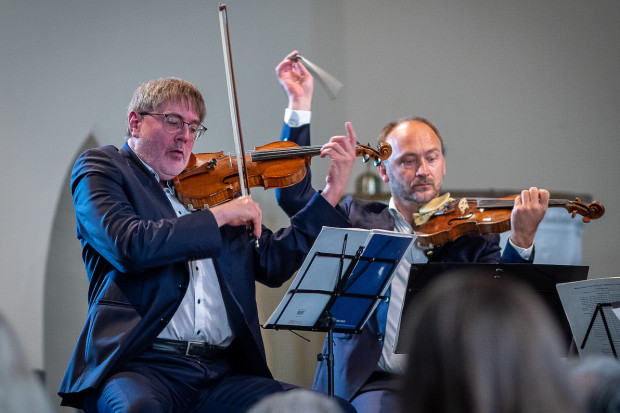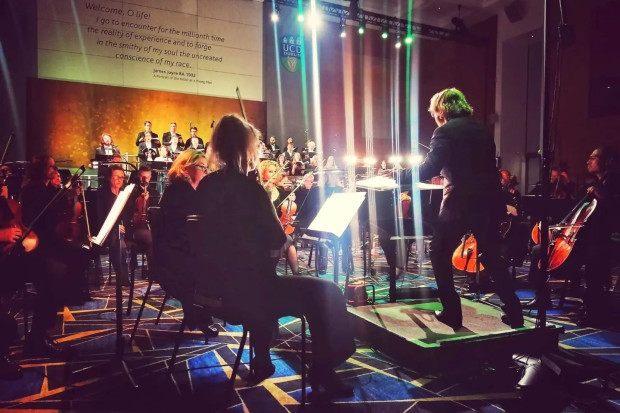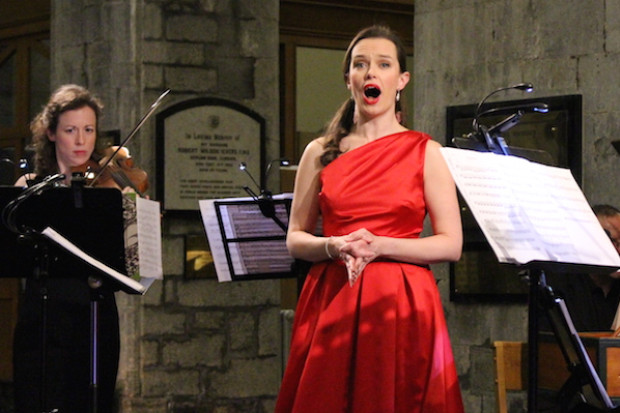
Jonathan Ware and Sharon Carty (Photo: Frances Marshall)
Exploring Schubert's Year
Schubert’s Four Seasons, a collection of lieder from Irish mezzo Sharon Carty and American pianist Jonathan Ware, is a long-planned project. The duo have been performing many of the works for several years, and, with the help of crowd-funding, have now been able to record this curated selection.
The album includes two large ballad-style works, Viola (1823) and Klage der Ceres (1815–16), along with seven other shorter lieder, such as Romanze (1823), Litanei auf das Fest Allerseelen (1816) and Der Winterabend (1828). While none of the pieces form a standard cycle, the works share common themes. Influenced by the changing of the seasons, each song has clear links to nature and reflections on life, love, loss and death, but mythology is also a thread that gives shape to this album. The final piece, Klage der Ceres, is an operatic-style lied detailing the myth of Demeter and her daughter Persephone, who was forced to spend six months each year in the Underworld. As the notes explain, during the months that Demeter is away from Persephone, she refuses to share ‘bountiful gifts with the inhabitants of the earth’. Her sorrow results in autumn and winter. As the album journeys through the calendar year, therefore, the moods of the myth are reflected in the choices for each season. Spring and summer feature lieder that are romantic and playful, whilst autumn and winter are more sombre. The lieder were composed throughout Schubert’s short life right up to his death and so this collection is as much a reflection of the seasons as it is of the composer himself.
The album opens with Viola, also known as The Flower Ballad, a large, 14-minute weaving song about a lovesick snowdrop awaiting her bridegroom in spring. The piano displays the delicacy of the flower followed by relentless energy and excitement. With each verse Carty’s vocal line responds to Schubert’s accompaniment, unveiling layers of emotion that guide the listener towards the final requiem of the lied. The melody is stripped to its simplest before the final repetition and Ware’s interpretation is beautifully played with enviable technique. Next is Goethe’s Ganymed (1817), depicting a young human called to Zeus’ side as his personal cupbearer. The poem is an expression of love to all the beauty of spring. This pretty piece is a showcase of Carty’s controlled and clear singing.
Versatility and intimacy
We move into summer with Die Sommernacht (1815), a short lied inspired by moonlight summer strolls. The gentle chordal accompaniment supports a lyrical vocal line that Carty approaches with restraint and strength. Romanze (1823) is adapted from the composer’s incidental music to the play Rosamunde and tells of the May moon shimmering over the countryside. The folk elements to this strophic piece fit with the text in this strikingly simple lied. For operatic singers like Carty, simple pared-back pieces like this are often the hardest to sing, but throughout the album she shows versatility in her technique that allows her to capture the intimacy of this collection.
The moon theme is extended into autumn, as we begin with An den Mond in einer Herbstnacht (1818) where the singer reminisces on all the moon has seen and accompanied them on throughout their life. The opening is filled with florid ornamentation expressing a dance-like quality, before moving to a sombre tone. Autumn ends with the Litany, for All Soul’s Day or Litanei auf das Fest Allerseelen (1816). This is a gorgeous piece that the pair do a magnificent job of. It is a quintessential Schubert lied; gentle and inviting on the ear, with deceptive complexity forming under every ebb of the melody.
The final three lieder belong to winter. Greisengesang (1823) is the dark and moody opening to the harshness of the season. The vocal line shows strength and colour, while the constantly harmonically changing Der Winterabend (1828) displays the musicianship of Carty. The concluding lied recaptures the myth the album has been sculpted by, but now using the Roman versions, with Demeter portrayed as Ceres in Klage der Ceres (1815–16). It is the second substantial ballad of the album and the most operatic in nature, recounting the full story with all the passion expected for such a tale. It is a fitting end to an album that lulls the listener on a journey, winding through the highs and lows of the changing seasons.
Music and poetry are equals in Schubert’s work, much like the relationship here with Carty and Ware. The song choice of the album fits so well together that I would not be surprised if more musicians chose to perform this carefully curated collection.
To purchase Schubert’s Four Seasons, visit www.genuin.de/en/04_d.php?k=561
Published on 25 June 2020
Tara Broderick is a teacher and graduate of CIT Cork School of Music. She was a participant in the Journal Music's 2019 Galway City and County Music Writer Mentoring Scheme.

















